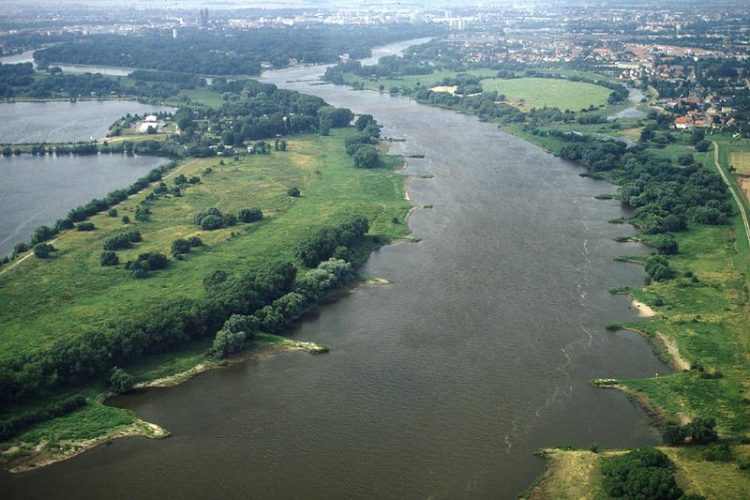New concept to help set priorities in water management

Engineering structures (rip-rap and standard groynes) along the shore of the Elbe River (Germany). M. Scholz, UFZ
It sounds rather simple: in order to restore the original high level of biodiversity in our rivers, they should be renaturalised, i.e. returned to their original state. Yet it really is not that easy as these efforts are often limited in practice, e.g. through historical, cultural or economic factors.
Furthermore, it is profoundly difficult for on-site researchers to examine the abundance of ecological factors and find the ones that take priority from an ecological perspective. All too often the priorities for action are stipulated in terms of technical and financial feasibility. This leads to elaborate renaturalisation measures often not achieving the sought-after success. But what are the right measures? Which priorities should be set?
To help with this decision-making process, researchers have developed the concept of ecological simplification and tested it in two river landscapes. The concept assumes that natural river landscapes are highly complex. This complexity involves various components, in particular spatial heterogeneity, the connectivity between spacial compartments and historical legacy. Human activity has influenced each of these components in various ways, inevitably reducing complexity.
In other words, it simplifies the system and thus reduces the number of ecological niches in which species can coexist. By systematically observing these components of complexity, causes of the simplification can be recognised and countermeasures can be introduced to remedy them. When selecting efficient management measures, it therefore makes a big difference whether the ecological problems arise from past transformations of habitat resulting from development of human infrastructure, from a history of pollution caused by chemicals, and/or from invasion by alien species.
In the case study, researchers carefully examined two rivers that primarily differ in terms of the duration of human influence: a river section of the Missouri River in eastern Montana (USA) with comparatively low human influence, and the Elbe River that flows through populated areas of north eastern Germany where it has been influenced by intensive agricultural activity, shaped as an important shipping lane, and isolated from its flood plains over most of its length. .
The authors’ concept recognizes that man-made bank structures such as the groyne fields of the River Elbe can be optimised for biodiversity. If they have the “right” shape, they can create ecological niches and increase the variety of species living there. A comparison of both rivers shows that although the original niche diversity of a natural location cannot be fully restored, certain parameters, e.g. the variety of food for the animals, are converging back to their natural state through the influence of man-made structures.
This knowledge makes it possible to compensate for losses in the variety of species that arose as a result of reducing the cross-section of the river created to make the river navigable. However, artificially increasing the complexity of the Elbe River also creates new problems, e.g. the fact that niches emerge in which invasive species can settle. This could make it difficult for native species to repopulate in the long term. As a result, the measures introduced need to take into consideration the amount of niches created as well as their quality for native species.
The research team now needs to start underpinning the theoretical concept with specific case studies and corresponding recommendations for action. They are currently dealing with the issue of how to improve the ecological compatibility of necessary man-made structures in rivers in an international consortium.
Publication:
Peipoch, Marc; Brauns, Mario; Hauer, F. Richard; Weitere, Markus; Valett, H. Maurice; (2015): Ecological simplification: human influences on riverscape complexity. http://dx.doi.org/10.1093/biosci/biv120
The study was funded in the USA by the National Science Foundation (NSF) EPSCoR Track-1 grant no. EPS-1101342 (INSTEP 3) through the Montana Institute on Ecosystems.
Further information:
Prof. H. Maurice Valett, Dr. Marc Peipoch Guell
University of Montana, Montana Institute on Ecosystems and Division of Biological Sciences
Tel. +1 (0)406-243-6058
http://hs.umt.edu/dbs/people/?s=Valett3809
http://www.umt.edu/directory/details/8f0990b07012074c51eaea6f974d01ee
and
Prof. Markus Weitere, Dr. Mario Brauns
Helmholtz Centre for Environmental Research (UFZ)
Tel.: +49 (0)391-810-9600, -9140
http://www.ufz.de/index.php?en=14086
https://www.ufz.de/index.php?en=21905
or via
Susanne Hufe (UFZ Press Office)
Tel.: +49 (0)341-235-1630
http://www.ufz.de/index.php?en=640
Media Contact
All latest news from the category: Ecology, The Environment and Conservation
This complex theme deals primarily with interactions between organisms and the environmental factors that impact them, but to a greater extent between individual inanimate environmental factors.
innovations-report offers informative reports and articles on topics such as climate protection, landscape conservation, ecological systems, wildlife and nature parks and ecosystem efficiency and balance.
Newest articles

Silicon Carbide Innovation Alliance to drive industrial-scale semiconductor work
Known for its ability to withstand extreme environments and high voltages, silicon carbide (SiC) is a semiconducting material made up of silicon and carbon atoms arranged into crystals that is…

New SPECT/CT technique shows impressive biomarker identification
…offers increased access for prostate cancer patients. A novel SPECT/CT acquisition method can accurately detect radiopharmaceutical biodistribution in a convenient manner for prostate cancer patients, opening the door for more…

How 3D printers can give robots a soft touch
Soft skin coverings and touch sensors have emerged as a promising feature for robots that are both safer and more intuitive for human interaction, but they are expensive and difficult…





















